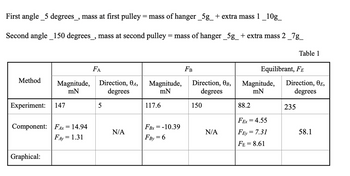Question
Complete the graphical method corresponding to the information provided

Transcribed Image Text:Graphical Method
On a piece of paper, construct (draw) a tail-to-head diagram of the vectors of force FA and force Fв (in
appropriate scale). Use a metric rule and a protractor to measure the magnitude and direction of the resultant
force. Find the equilibrant force magnitude and direction. Record the results in Table 1.
If you do not have the protractor, you can use the right triangle method to build or measure the angle: tangent
of an angle is the length of the side opposite the angle divided by the length of the adjacent side.
In conclusion, discuss how the theoretical and graphical values for the magnitude and direction of the
equilibrant force compare to the actual (experimental) magnitude and direction.

Transcribed Image Text:First angle_5 degrees_, mass at first pulley = mass of hanger _5g_ + extra mass 1_10g_
Second angle_150 degrees_, mass at second pulley = mass of hanger _5g_ + extra mass 2 _7g_
Method
Experiment:
Graphical:
Magnitude, Direction, 04,
mN
degrees
147
Component: FAx = 14.94
FAy = 1.31
FA
5
N/A
Magnitude,
mN
117.6
FBx = -10.39
FBy=
= 6
FB
Direction, 0B,
degrees
150
N/A
Magnitude,
mN
88.2
Equilibrant, FE
FEx = 4.55
FEy = 7.31
FE = 8.61
Table 1
Direction, E,
degrees
235
58.1
Expert Solution
This question has been solved!
Explore an expertly crafted, step-by-step solution for a thorough understanding of key concepts.
Step by stepSolved in 3 steps with 2 images

Knowledge Booster
Similar questions
- Refer attached picture. Please check the answer in picture containing the question before submitting the solution.arrow_forwardPlease use the result of "-1,970" from the first question to find the answer to the other question. Thank you!arrow_forwardWhy not draw the line on my graph by simply connecting two of the data points, for example the first and last ones?arrow_forward
- Answer The following problem. Base on the given Table. Show complete solutions. View Imagearrow_forwardLast guy got every single answer wrong! pls answer carefully im on last attemptarrow_forwardPlease only answer if you’re 100% sure PLEASE! Please show all the equations and STEPS to resolve this problem pleasearrow_forward
arrow_back_ios
SEE MORE QUESTIONS
arrow_forward_ios